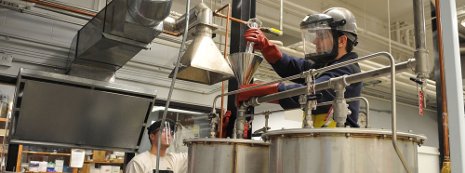Improving electrokinetic microdevice stability by controlling electrolysis bubbles
Document Type
Article
Publication Date
3-20-2014
Abstract
The voltage‐operating window for many electrokinetic microdevices is limited by electrolysis gas bubbles that destabilize microfluidic system causing noise and irreproducible responses above ∼3 V DC and less than ∼1 kHz AC at 3 Vpp. Surfactant additives, SDS and Triton X‐100, and an integrated semipermeable SnakeSkin® membrane were employed to control and assess electrolysis bubbles from platinum electrodes in a 180 by 70 μm, 10 mm long microchannel. Stabilized current responses at 100 V DC were observed with surfactant additives or SnakeSkin® barriers. Electrolysis bubble behaviors, visualized via video microscopy at the electrode surface and in the microchannels, were found to be influenced by surfactant function and SnakeSkin® barriers. Both SDS and Triton X‐100 surfactants promoted smaller bubble diameters and faster bubble detachment from electrode surfaces via increasing gas solubility. In contrast, SnakeSkin® membranes enhanced natural convection and blocked bubbles from entering the microchannels and thus reduced current disturbances in the electric field. This data illustrated that electrode surface behaviors had substantially greater impacts on current stability than microbubbles within microchannels. Thus, physically blocking bubbles from microchannels is less effective than electrode functionalization approaches to stabilize electrokinetic microfluidic systems.
Publication Title
Electrophoresis
Recommended Citation
Lee, H. Y.,
Barber, C.,
&
Minerick, A.
(2014).
Improving electrokinetic microdevice stability by controlling electrolysis bubbles.
Electrophoresis,
35, 1782-1789.
http://doi.org/10.1002/elps.201400013
Retrieved from: https://digitalcommons.mtu.edu/chemical-fp/10


Publisher's Statement
© 2014 WILEY‐VCH Verlag GmbH & Co. KGaA, Weinheim. Publisher's version of record: https://doi.org/10.1002/elps.201400013